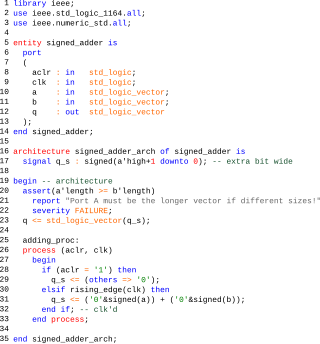Related Research Articles

Interoperability is a characteristic of a product or system to work with other products or systems. While the term was initially defined for information technology or systems engineering services to allow for information exchange, a broader definition takes into account social, political, and organizational factors that impact system-to-system performance.

MIL-STD-188 is a series of U.S. military standards relating to telecommunications.

VHDL is a hardware description language that can model the behavior and structure of digital systems at multiple levels of abstraction, ranging from the system level down to that of logic gates, for design entry, documentation, and verification purposes. The language was developed for the US military VHSIC program in the 1980s, and has been standardized by the Institute of Electrical and Electronics Engineers (IEEE) as IEEE Std 1076; the latest version of which is IEEE Std 1076-2019. To model analog and mixed-signal systems, an IEEE-standardized HDL based on VHDL called VHDL-AMS has been developed.

IDEF, initially an abbreviation of ICAM Definition and renamed in 1999 as Integration Definition, is a family of modeling languages in the field of systems and software engineering. They cover a wide range of uses from functional modeling to data, simulation, object-oriented analysis and design, and knowledge acquisition. These definition languages were developed under funding from U.S. Air Force and, although still most commonly used by them and other military and United States Department of Defense (DoD) agencies, are in the public domain.
ISO/IEC/IEEE 12207Systems and software engineering – Software life cycle processes is an international standard for software lifecycle processes. First introduced in 1995, it aims to be a primary standard that defines all the processes required for developing and maintaining software systems, including the outcomes and/or activities of each process.
The High Level Architecture (HLA) is a standard for distributed simulation, used when building a simulation for a larger purpose by combining (federating) several simulations. The standard was developed in the 1990s under the leadership of the US Department of Defense and was later transitioned to become an open international IEEE standard. It is a recommended standard within NATO through STANAG 4603. Today the HLA is used in a number of domains including defense and security and civilian applications.
Distributed Interactive Simulation (DIS) is an IEEE standard for conducting real-time platform-level wargaming across multiple host computers and is used worldwide, especially by military organizations but also by other agencies such as those involved in space exploration and medicine.

The Department of Defense Architecture Framework (DoDAF) is an architecture framework for the United States Department of Defense (DoD) that provides visualization infrastructure for specific stakeholders concerns through viewpoints organized by various views. These views are artifacts for visualizing, understanding, and assimilating the broad scope and complexities of an architecture description through tabular, structural, behavioral, ontological, pictorial, temporal, graphical, probabilistic, or alternative conceptual means. The current release is DoDAF 2.02.
A United States defense standard, often called a military standard, "MIL-STD", "MIL-SPEC", or (informally) "MilSpecs", is used to help achieve standardization objectives by the U.S. Department of Defense.

The Common Image Generator Interface (CIGI), is an on-the-wire data protocol that allows communication between an Image Generator and its host simulation. The interface is designed to promote a standard way for a host device to communicate with an image generator (IG) within the industry.
A Battle Management Language (BML) is the unambiguous language used to command and control forces and equipment conducting military operations and to provide situational awareness and a shared, common operational picture.
Capability management is a high-level management function, with particular application in the context of defense.
The Simulation Interoperability Standards Organization (SISO) is an organization dedicated to the promotion of modeling and simulation interoperability and reuse for the benefit of diverse modeling and simulation communities, including developers, procurers, and users, worldwide.
Live, Virtual, & Constructive (LVC) Simulation is a broadly used taxonomy for classifying Modeling and Simulation (M&S). However, categorizing a simulation as a live, virtual, or constructive environment is problematic since there is no clear division among these categories. The degree of human participation in a simulation is infinitely variable, as is the degree of equipment realism. The categorization of simulations also lacks a category for simulated people working real equipment.
A capability, in the systems engineering sense, is defined as the ability to execute a specified course of action. A capability may or may not be accompanied by an intention. The term is used in the defense industry but also in private industry.
The Standard Interface for Multiple Platform Link Evaluation (SIMPLE) is a military communications protocol defined in NATO's Standardization Agreement STANAG 5602.
MAK Technologies, formerly doing business as VT MAK, Inc. is a software company based in Cambridge, Massachusetts that provides commercial off-the-shelf (COTS) modeling and simulation software. The company develops and sells software for distributed simulations that system integrators, governments, and research institutions use to build and populate 3D simulated environments. Users include medical, aerospace, defense, and transportation industries. In addition to offering COTS software, MAK provides the following services: simulation content creation, software customization, interoperability, research and development, and training.
Distributed Simulation Engineering and Execution Process (DSEEP) is a standardized process for building federations of computer simulations. DSEEP is maintained by SISO and the standard is published as IEEE Std 1730-2010. DSEEP is a recommended systems engineering process in the NATO Modelling and Simulation Standards Profile AMSP-01, which also uses DSEEP as a framework for describing when other standards are to be used throughout a project process.
The Real-time Platform Reference Federation Object Model enables linking computer simulations of discrete physical entities into complex virtual worlds. It is a High Level Architecture (HLA) federation object model developed for distributed simulation applications of defense and security. RPR FOM is listed in the NATO Modelling and Simulation Standards Profile AMSP-01.
Katherine Lee Morse is an American computer scientist whose work has centered on distributed simulation, on the integration of heterogenous simulation environments, and on standardization of methods for interoperability in simulation, including participating in the development of the High Level Architecture for modeling and simulation. She is a member of the principal professional staff at the Johns Hopkins University Applied Physics Laboratory.
References
- ↑ "Command and Control Systems - Simulation Systems Interoperation (C2SIM) Product Development Group (PDG) and Product Support Group (PSG)" . Retrieved 5 November 2015.
- ↑ "SISO-STD-007-2008: Military Scenario Definition Language (MSDL)" (PDF). Retrieved 18 November 2024.